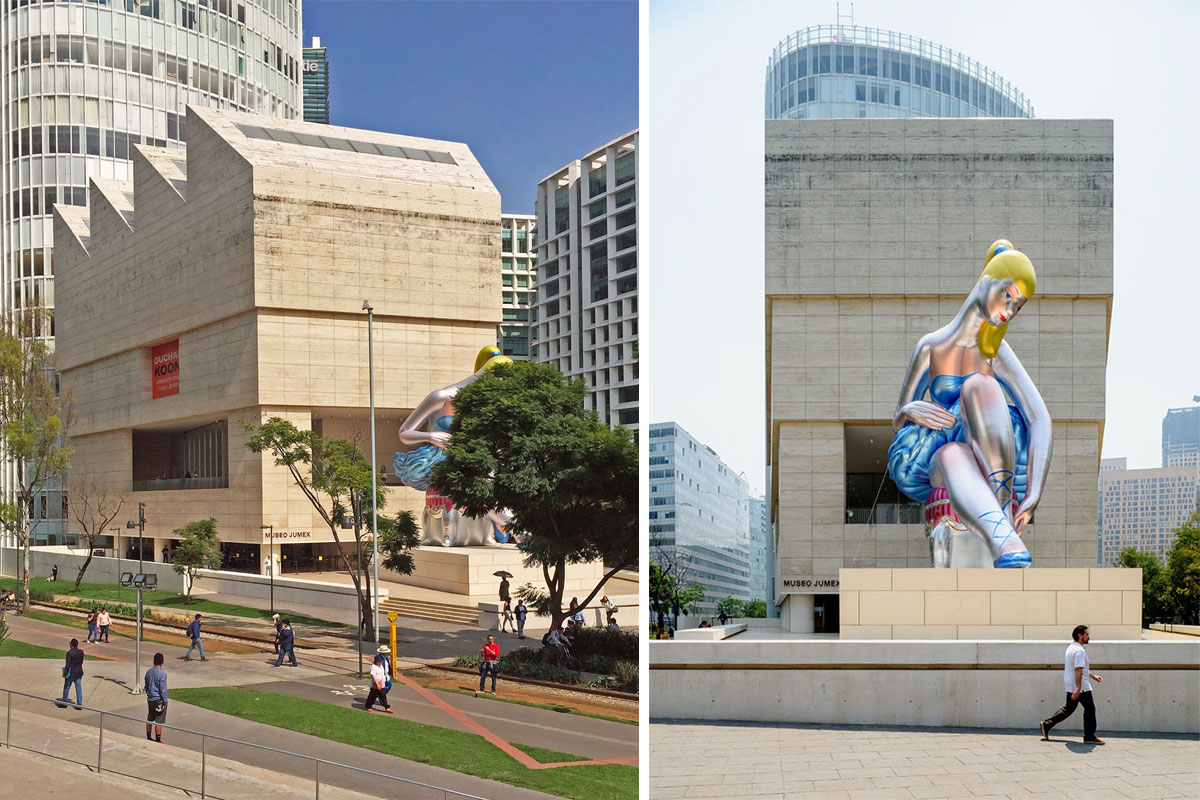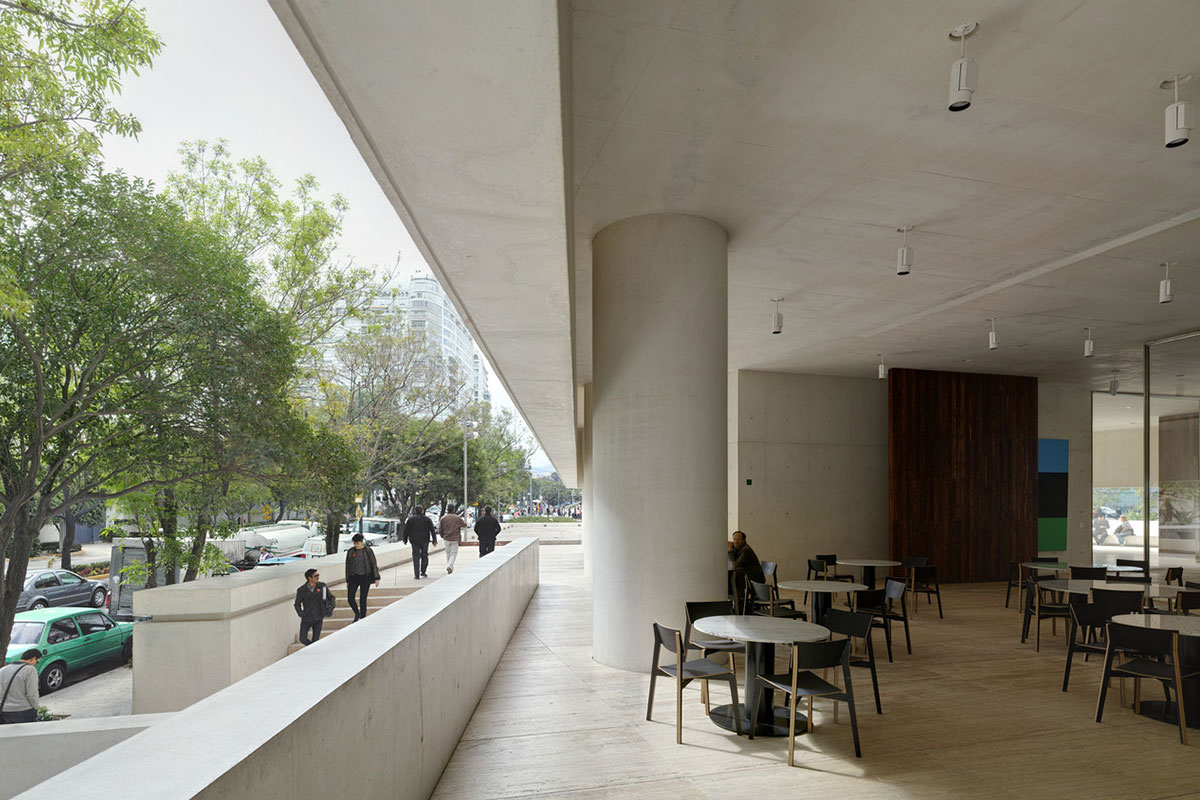It is a hot and sunny morning towards the end of summer. I slowly walk up the Bulevar Miguel de Cervantes Saavedra when suddenly the Jumex Museum appears on my right, occupying a triangular plot in between the main avenue and an old railway. I imagine the old trains transporting the barley grains to the beer factory, located a little bit further west, where they produce Modelo, Corona and other Mexican beers.
Jumex is a popular Mexican juice company that, through its foundation, has become one of the major patrons in the art world under the direction of Eugenio Lopez Alonso, the only heir of the juice empire. The museum opened in 2013 was designed by David Chipperfield Architects and promotes contemporary art of the highest calibre.

Left: Mexico City’s Jumex Museum, designed by David Chipperfield Architects opened in 2013 and houses the Colección Jumex, the private art collection of Eugenio López Alonso. Alonso is the sole heir of the Jumex juice empire. Photograph by Antonio Moll
Right: Jeff Koons’ 45-foot-high inflatable nylon sculpture – Seated Ballerina – outside the Jumex Museum. The work is a contemporary interpretation of the mythological goddess Venus. Photograph by Moritz Bernoully.
Uncovering the pre-Columbian Mexico
The museum presents a serene and calm demeanour, a jewel box cladded with massive Mexican travertine tiles from Xalapa of a light and creamy colour. The building reminds me of the Aztec pyramids, just in this case it steps upside down. Each step defines a different exhibition space and a few large openings in the walls expose visitors to the outside, helping to give scale to the size of the construction.
Trying to escape from the heat, I walk around the front of the building and go up to the piazza where the entrance to the museum resides. Like an ancient temple it detaches itself from its surroundings, allowing visitors that pleasure of the slightly elevated point of view. A continuous concrete bench borders the space, from where I observe the urban chaos of cars and people rushing about some meters below.

The Jumex Museum, Mexico City is clad in travertine stone from Xalapa, Veracruz, Mexico and is supported by large columns resting on an elevated piazza. Photograph by Antonio Moll.
Entering the Jumex Museum
The shade of the building, hovering over the piazza, provides a welcome feeling of freshness. An air of austere elegance defines the space. I take a few steps across the piazza, pass through a line of big concrete columns and enter the museum. Access is by means of an intermediate space between the outdoors and the indoors, covered but open, very appropriate for the local climate.
Looking back outside, I can’t help but remember my visit some time ago to the Barcelona Pavilion by Mies Van der Rohe. The travertine, the glass walls with the steel joinery, the perimeter bench, the piazza, all relates back to Mies. I then turn around and start my visit by taking the lift to the third floor, buying a surprisingly cheap ticket for thirty pesos – equal to a couple of humble “tacos al pastor” – on the way. I can’t believe that I can visit an exhibition exploring parallels between the work of Jeff Koons and Marcel Duchamp for that price.

Restaurant Eno and museum shop at the piazza level of the Jumex Museum, Mexico City by David Chipperfield Architects. Photographs from Plataform arquitectura by Simon Menges.

Restaurant Eno and museum shop at the piazza level of the Jumex Museum, Mexico City by David Chipperfield Architects. Photographs from Plataform arquitectura by Simon Menges.
The spatial pleasure of the Jumex Museum
Each exhibition space has different lighting and height, which offers variety for artists and curators alike. The top floor is the biggest space of the three and has the highest ceilings. It is covered by the sequence of saw-tooth skylights that enlighten the space from above, with a sort of misty light, and give the museum a scaled up atelier image from the outside. The second floor is the shortest. The only opening has been roped off for a show, turning the room into a sealed container that lets the art be the protagonist.
Down on the first floor, the city reveals itself again. The light invades the entire floor through the full length glass panes, and the surrounding gallery has balconies on each of the four sides that provide the visitor with a relaxed environment from where to observe life in the busy square below.

Left: The top floor at the Jumex Museum is the biggest exhibition space in the building. It is lit by saw-tooth skylights which from the outside give the impression of a large studio. Photograph by Antonio Moll.
Right: Balconies extend on all four sides from the first floor gallery space at the Jumex Museum in Mexico City, giving visitors an opportunity to observe life in the busy piazza below. Photograph by Antonio Moll
Exploring the underground
I take the stairs down once again and avoid the temptation of finishing my visit at the shop and restaurant in the lobby – the latter is run by Michelin-starred chef Enrique Olvera. I venture down to the basement and my discipline is rewarded. Preceding the most elegant toilet ever built in a museum, there is a small exhibition room covered with a carpet of multi-coloured marble stripes created by Martin Creed. It felt like discovering a secret room, behind a hidden door; an authentic wonder chamber inside the pyramid that Jumex has built as an offering to the people.

In the basement of the Jumex Museum is a small exhibition room covered with a striking carpet of multi-coloured marble stripes created by Martin Creed. Photograph by Moritz Bernoully from The Fountain Archives.

The WCs housed in the basement of the Jumex museum are clad in full-height marble. Designed by David Chipperfield Architects. Photograph by Antonio Moll.